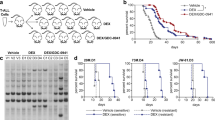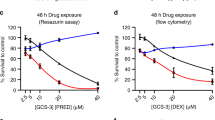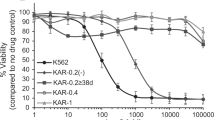Abstract
The molecular basis for the clinical presentation of broad-range drug resistance in childhood ALL is poorly understood. In this study, high level cross-resistance to the glucocorticoid dexamethasone was encountered in a childhood ALL cell line selected for resistance to methotrexate (CEM MTX-R3). Compared with wild-type (WT) CEM cells, MTX-R3 cells had significantly fewer glucocorticoid binding sites, as well as reduced glucocorticoid receptor protein and mRNA levels. DNA sequencing and restriction fragment-length polymorphism (RFLP) analysis showed that WT cells expressed both a wild-type and a mutant (GR753F) glucocorticoid receptor allele, while MTX-R3 cells expressed only the GR753F allele. Therefore, the cross-resistance of MTX-R3 cells to dexamethasone appeared due to loss of expression of the wild-type glucocorticoid receptor allele. In an effort to gain insight into the underlying basis for the development of cross-resistance to methotrexate and glucocorticoids, glucocorticoid receptor nuclear translocation experiments were carried out. Exposure of WT cells to either dexamethasone or the cytotoxic agents cytarabine and methotrexate caused translocation of the glucocorticoid receptor from the cytoplasm into the nucleus. These data indicate that exposure of childhood ALL cells to cytotoxic agents may result in ligand-independent glucocorticoid receptor activation which, in the context of the outgrowth of drug-resistant cells, could lead to the co-selection of glucocorticoid resistance.
This is a preview of subscription content, access via your institution
Access options
Subscribe to this journal
Receive 12 print issues and online access
$259.00 per year
only $21.58 per issue
Buy this article
- Purchase on Springer Link
- Instant access to full article PDF
Prices may be subject to local taxes which are calculated during checkout





Similar content being viewed by others
References
Gaynon PS, Qu RP, Chappell RJ, Willoughby MLN, Tubergen DG, Steinherz PG, Trigg ME . Survival after relapse in childhood acute lymphoblastic leukemia: impact of site and time to first relapse – the Children's Cancer Group Experience Cancer 1998 82: 1387–1395
Klumper E, Pieters R, Veerman AJP, Huismans DR, Loonen AH, Hählen K, Kaspers GJL, van Wering ER, Hartmann R, Henze G . In vitro cellular drug resistance in children with relapsed/refractory acute lymphoblastic leukemia Blood 1995 86: 3861–3868
Wolff C, Brubaker M, Murphy M, Pierce M, Severo N . Prednisone therapy of acute childhood leukemia: prognosis and duration of response in 330 treated patients J Pediat 1967 70: 626–631
Pfahl M, Kelleher RJ Jr, Bourgeois S . General features of steroid resistance in lymphoid cell lines Mol Cell Endocrinol 1978 10: 193–207
Foley GE, Lazarus H, Farber S, Uzman BG, Boone BA, McCarthy RE . Continuous culture of human lymphoblasts from peripheral blood of a child with acute leukemia Cancer 1965 18: 522–529
Powers JH, Hillmann AG, Tang DC, Harmon JM . Cloning and expression of mutant glucocorticoid receptors from glucocorticoid-sensitive and resistant human leukemic cells Cancer Res 1993 53: 4059–4065
Ashraf J, Thompson EB . Identification of the activation-labile gene: a single point mutation in the human glucocorticoid receptor presents as two distinct receptor phenotypes Mol Endocrinol 1993 7: 631–642
Strasser-Wozak EM, Hattmannstorfer R, Hála M, Hartmann BL, Fiegl M, Geley S, Kofler R . Splice site mutation in the glucocorticoid receptor gene causes resistance to glucocorticoid-induced apoptosis in a human acute leukemic cell line Cancer Res 1995 55: 348–353
Hala M, Hartmann BL, Bock G, Geley S, Kofler R . Glucocorticoid-receptor-gene defects and resistance to glucocorticoid-induced apoptosis in human leukemic cell lines Int J Cancer 1996 68: 663–668
Geley S, Hartmann BL, Hala M, Strasser-Wozak EM, Kapelari K, Kofler R . Resistance to glucocorticoid-induced apoptosis in human T-cell acute lymphoblastic leukemia CEM-C1 cells is due to insufficient glucocorticoid receptor expression Cancer Res 1996 56: 5033–5038
Palmer LA, Harmon JM . Biochemical evidence that glucocorticoid-sensitive cell lines derived from the human leukemic cell line CCRF-CEM express a normal and a mutant glucocorticoid receptor gene Cancer Res 1991 51: 5224–5231
Haber M, Reed C, Kavallaris M, Norris MD, Stewart BW . Resistance to drugs associated with the multidrug resistance phenotype following selection with high-concentration methotrexate J Natl Cancer Inst 1989 81: 1250–1254
Borsi JD, Moe PJ . A comparative study of the pharmacokinetics of methotrexate in a dose range of 0.5 g to 33.6 g/m2 in children with acute lymphoblastic leukemia Cancer 1987 60: 5–13
Kavallaris M, Haber M, Norris MD, Matherly LH, Stewart BW . Characterization of mechanisms mediating drug resistance in human leukemic cells selected with high concentration methotrexate Pteridines 1992 3: 119–121
Norris MD, De Graaf D, Haber M, Kavallaris M, Madafiglio J, Gilbert J, Kwan E, Stewart BW, Mechetner EB, Gudkov AV, Roninson IB . Involvement of MDR1 P-glycoprotein in multifactorial resistance to methotrexate Int J Cancer 1996 65: 613–619
Gifford AJ, Kavallaris M, Madafiglio J, Matherly LH, Stewart BW, Haber M, Norris MD . P-glycoprotein-mediated methotrexate resistance in CCRF-CEM sublines deficient in methotrexate accumulation due to a point mutation in the reduced folate carrier gene Int J Cancer 1998 78: 176–181
Scatchard G . The attractions of proteins for small molecules and ions Ann NY Acad Sci 1949 51: 660–672
Harmon JM, Thompson EB . Isolation and characterization of dexamethasone-resistant mutants from human lymphoid cell line CEM-C7 Mol Cell Biol 1981 1: 512–521
Harmon JM, Schmidt TJ, Thompson EB . Molybdate-sensitive and molybdate-resistant activation-labile glucocorticoid-receptor mutants of the human lymphoid cell line CEM-C7 J Steroid Biochem 1984 21: 227–236
Bradford MM . A rapid and sensitive method for the quantitation of microgram quantities of protein utilizing the principle of protein-dye binding Anal Biochem 1976 72: 248–254
Smets L, Salomons G, van Rooij H, van den Berg J . Involvement of the glucocorticoid receptor in stress-induced apoptosis of leukemic cells Leukemia 1998 12: 406–413
Murphy KM, Streips UN, Lock RB . Bax membrane insertion during Fas(CD95)-induced apoptosis precedes cytochrome c release and is inhibited by Bcl-2 Oncogene 1999 18: 5991–5999
Murphy KM, Streips UN, Lock RB . Bcl-2 inhibits a Fas-induced conformational change in the Bax N terminus and Bax mitochondrial translocation J Biol Chem 2000 275: 17225–17228
Sambrook J, Fritsch EJ, Maniatis T . Molecular cloning: A Laboratory Manual, 2nd edn, Cold Spring Harbor Laboratory Press: New York 1989
Hollenberg SM, Weinberger C, Ong ES, Cerelli G, Oro A, Lebo R, Thompson EB, Rosenfeld MG, Evans RM . Primary structure and expression of a functional human glucocorticoid receptor cDNA Nature 1985 318: 635–641
Palmer LA, Hukku B, Harmon JM . Human glucocorticoid receptor gene deletion following exposure to cancer chemotherapeutic drugs and chemical mutagens Cancer Res 1992 52: 6612–6618
Norman MR, Thompson EB . Characterization of a glucocorticoid-sensitive human lymphoid cell line Cancer Res 1977 37: 3785–3791
Ercolani L, Florence B, Denaro M, Alexander M . Isolation and complete sequence of a functional human glyceraldehyde-3-phosphate dehydrogenase gene J Biol Chem 1988 263: 15335–15341
Acknowledgements
This work was supported by the Children's Cancer Institute Australia for Medical Research, which is affiliated with the University of New South Wales and Sydney Children's Hospital.
Author information
Authors and Affiliations
Rights and permissions
About this article
Cite this article
Catts, V., Farnsworth, M., Haber, M. et al. High level resistance to glucocorticoids, associated with a dysfunctional glucocorticoid receptor, in childhood acute lymphoblastic leukemia cells selected for methotrexate resistance. Leukemia 15, 929–935 (2001). https://doi.org/10.1038/sj.leu.2402128
Received:
Accepted:
Published:
Issue Date:
DOI: https://doi.org/10.1038/sj.leu.2402128
Keywords
This article is cited by
-
Authenticity and drug resistance in a panel of acute lymphoblastic leukaemia cell lines
British Journal of Cancer (2006)
-
An MMP-2/MMP-9 inhibitor, 5a, enhances apoptosis induced by ligands of the TNF receptor superfamily in cancer cells
Cell Death & Differentiation (2003)



